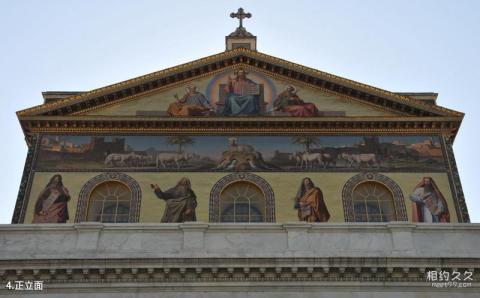
Introduction to the front facade: The colorful stone mosaic above the main entrance of the temple was made between 1854 and 1874 based on the manuscripts of two masters, Filippo Agricola (1795-1857) and Nicola Consoni (1814-84). The entire facade is divided into three parts:
Below are the four prophets of the Old Testament: Isaiah, Jeremiah, Ezekiel, and Daniel, holding scrolls writing prophecies, standing on On four sections of wall between three arched windows.
The narrower long banner on it is full of meaning: the halo of light above the head of the savior lamb sitting on the hill in the center of the picture symbolizes Christ, who is solemnly preaching. Four clear springs flow out from under the hillock, symbolizing the four gospels and the life of Christ. The twelve lambs walking toward the living spring of eternal life from the left and right sides respectively symbolize the twelve apostles, or all Christians; the cities at the left and right ends of the banner symbolize Bethlehem and Jerusalem respectively, which are the places where Jesus was born and died. In the background Palm trees symbolize eternal life.
On the topmost triangular gable, Christ sits solemnly on the throne in the form of a king, with a large halo symbolizing the kingdom of heaven surrounding His figure. There is also a cross aperture above his head. Christ the King holds an open scroll in his left hand and is blessing all living beings in his right hand. Peter, holding the keys, and Paul, holding the sword, accompany Christ on either side. At the top of the church stands the cross symbolizing salvation.
